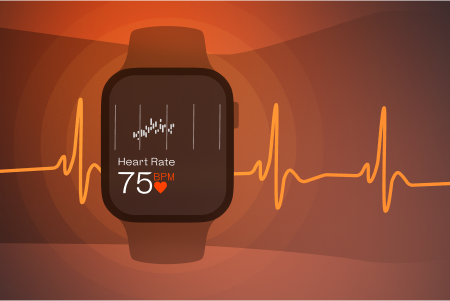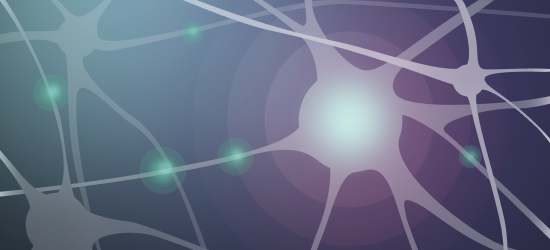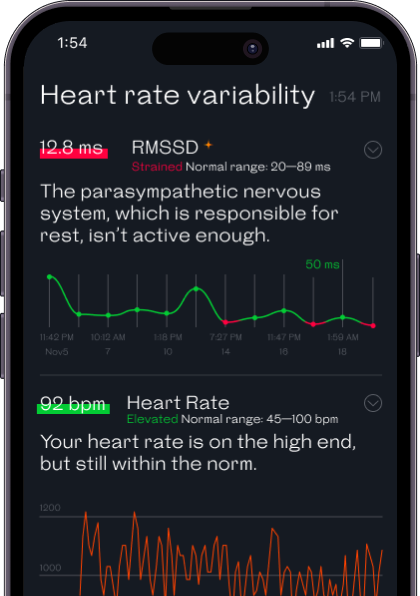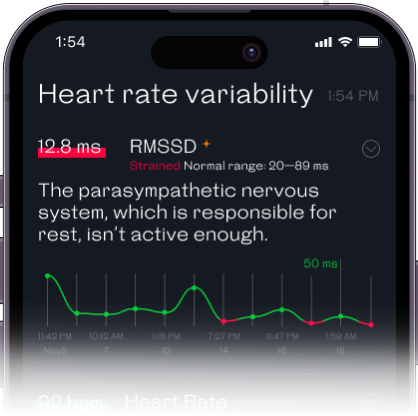


Welltory is the Ultimate HRV App




Home » Heart Rate Variability » Sympathetic vs Parasympathetic Nervous System

The human body is a complex and efficient system, constantly adapting to various internal and external stimuli. One essential aspect of maintaining homeostasis is the autonomic nervous system (ANS), which is further divided into two branches: the sympathetic and parasympathetic nervous systems.
Understanding the balance between these two systems is crucial to optimizing physical and mental health. We’ll explore the differences between the sympathetic and parasympathetic nervous systems, their functions, and the significance of Heart Rate Variability (HRV) in assessing their balance.
The sympathetic nervous system (SNS) is responsible for preparing the body to respond to threats or stressors, thus activating the “fight or flight” response. When the SNS is activated, it triggers several physiological changes, such as increased heart rate, increased blood pressure, and the release of stress hormones like adrenaline and cortisol [1]. These changes enable the body to react quickly and effectively to challenges, ensuring survival.
Conversely, the parasympathetic nervous system (PNS) is responsible for promoting relaxation and recovery. It activates the “rest and digest” response, allowing the body to slow down, conserve energy, and focus on essential processes like digestion, repair, and growth [1]. When the PNS is active, heart rate and blood pressure decrease, and the body shifts towards a state of rest and restoration.
A healthy body requires a balance between the SNS and PNS. In an ideal state, the sympathetic system responds to stressors and quickly returns to baseline when the threat is gone, while the parasympathetic system promotes recovery and maintains internal balance. However, chronic stress, poor lifestyle choices, and other factors can disrupt this balance, leading to health issues such as cardiovascular disease, anxiety, and poor immune function [2].
To better understand the balance between the SNS and PNS, it is essential to explore the physiological processes and mechanisms that underlie their activation.
Sympathetic Nervous System Activation: The SNS is responsible for the “fight or flight” response, which prepares the body for action in the face of perceived threats. When activated, the SNS increases heart rate, constricts blood vessels, and redirects blood flow to the muscles. This response is mediated by the release of neurotransmitters like norepinephrine, which helps mobilize the body’s energy reserves [3].
Parasympathetic Nervous System Activation: In contrast, the PNS promotes the “rest and digest” response, which helps the body recover and conserve energy. The PNS slows down the heart rate, dilates blood vessels, and stimulates digestion. The primary neurotransmitter involved in PNS activation is acetylcholine, which promotes relaxation and restoration [4].
Balancing Act: The ANS is a dynamic system that constantly adjusts to internal and external stimuli. The balance between the SNS and PNS is maintained through a complex interplay of neural and hormonal signals. In a healthy individual, the SNS and PNS work together to ensure an appropriate physiological response to various situations. For instance, during exercise, the SNS increases heart rate and blood flow to the muscles, while the PNS activity is reduced to allow for optimal performance. After exercise, the PNS takes over to promote recovery and restoration.
Get Welltory
to track HRV
Get Welltory
to track HRV



Heart Rate Variability (HRV) is a powerful tool for assessing the balance between the sympathetic and parasympathetic nervous systems. HRV measures the variations in time between successive heartbeats, reflecting the dynamic interplay between the SNS and PNS [5]. Higher HRV is typically associated with a healthier balance, better stress resilience, and overall well-being, while lower HRV may indicate an imbalance or reduced adaptability to stress [6].
Research has shown that HRV can provide valuable insights into cardiovascular health, mental health, and overall wellness. For instance, a study found that individuals with higher HRV had a lower risk of developing coronary artery disease. Additionally, HRV has been linked to emotional regulation and resilience, with lower HRV being associated with anxiety and depression [7].
Welltory uses your smartphone’s camera or a compatible wearable device to measure your HRV, providing you with insights into your ANS balance and stress resilience. By tracking your HRV data over time, you can observe trends, identify patterns, and make informed decisions about your lifestyle choices to optimize your ANS balance.
Welltory offers personalized recommendations based on your HRV data and other factors, such as sleep, physical activity, and emotional well-being. These recommendations can help you implement strategies to manage stress, improve exercise routines, prioritize sleep, maintain a balanced diet, and foster social connections, all of which contribute to a healthier ANS balance.
With Welltory, you can better understand your body’s stress and recovery levels, allowing you to make adjustments to your daily routine to prevent burnout and optimize recovery. By understanding when you need to rest or when you can push harder, you can achieve a healthier balance between the SNS and PNS.
Welltory offers a library of guided breathing exercises and relaxation techniques that can help activate your parasympathetic nervous system and reduce stress. By incorporating these practices into your daily routine, you can improve your ANS balance and overall well-being.
The synergy between the sympathetic and parasympathetic nervous systems is a testament to the incredible complexity and adaptability of the human body. As we delve into the insights offered by HRV and the inner workings of the SNS and PNS, we are reminded of the importance of maintaining equilibrium for a healthier, more fulfilling life.
Welltory Team, 16 Mar. 2023
 App Store
App Store
 Google Play
Google Play
 Huawei AppGallery
Huawei AppGallery
 Galaxy Store
Galaxy Store

